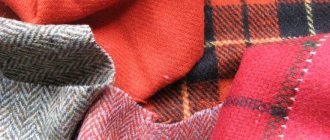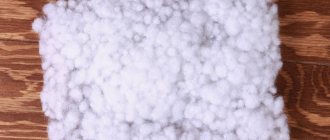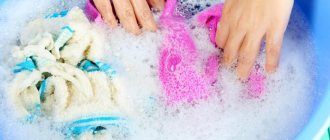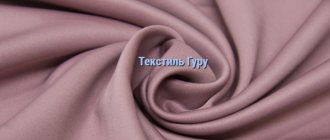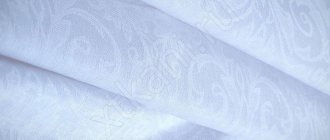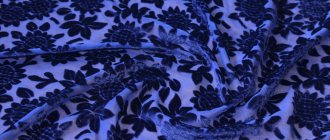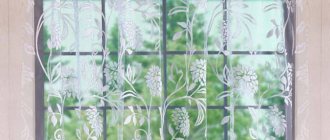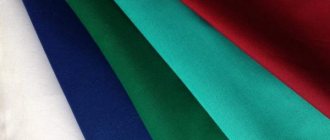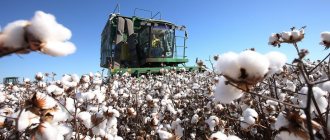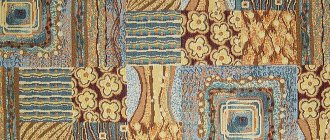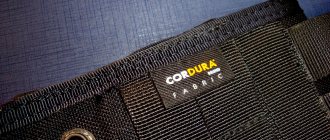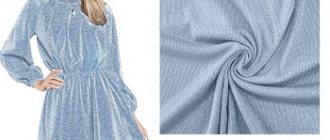Of the huge variety of modern materials for the clothing industry, diving especially stands out for its properties. In production it is called “sport knitwear” and is one of the types of knitwear in the manufacture of which artificial fibers are used. The fabric belongs to the category of innovative materials. The new generation of soft and elastic knitwear perfectly fits the figure without restricting movement, which is why it is called “second skin”. The amazing characteristics of diving fabric have brought it unprecedented popularity, especially among young people.
Story
Knitwear as a fabric was first produced at the end of the 19th century. Initially, it was made exclusively from artificial materials, but it quickly gained popularity. At this time, a large number of companies picked up this invention and began to implement them in their industries.
What kind of material
Already at the beginning of the 20th century, after a series of developments, artificial silk and viscose appeared. By the end of the century, the production of polyurethane threads was established at the GIPROIV Institute. At the time of rapid development, they tried to use synthetic threads as an experiment in machine knitting. This is how a fabric with unique properties appeared - diving.
Initially, the new fabric was called “sports jersey”, because it was ideally used in the production of sports suits and clothing for active recreation. Now this fabric is used in sewing casual clothes, elegant dresses, and in many other areas.
Diving dress
Visual characteristics and composition
The canvas is a dense, smooth, plain material. The fabric is soft to the touch, pleasant to the body. The front part is usually more shiny. The reverse side is matte, sometimes with short pile.
- Lycra, originally invented by Shivers, occupies no more than 5% of the modern material.
- Synthetic fibers - polyester - account for about 30% of the composition.
- The main component of the fabric was viscose. Diving fabric consists of 60-65% artificial fibers obtained from cotton processing.
Thanks to new technologies, clothing has retained its elasticity and density, while the composition is as close to natural as possible.
Manufacturing Features
Diving fabric has its own production characteristics - it contains three types of raw materials.
- Viscose. The percentage of this fiber in the fabric is highest - at least 65%. This is explained by the fact that viscose, as a material, is very close to natural, therefore it allows air to pass through well and allows the skin to breathe. In addition, thanks to the fiber, the fabric has its own special shine, similar to satin or silk, or a matte sheen. Viscose itself is made from cellulose.
- Polyester. It contains about half as much as viscose - about 30%. Polyester is a synthetic material that gives divers durability and durability.
- Lycra (elastane, spandex). There is a very small part of it in the fabric - less than 5%. Lycra fibers make the fabric elastic and stretchable.
Material with a matte sheen
In addition to the above-mentioned fibers, cotton is sometimes added to diving (it makes up no more than 10%). This is necessary so that the material can better allow air to pass through and make the body comfortable. This is true, for example, for summer clothes.
This will be interesting to you All about Minky plush: what it means and what it consists of
The fabric is produced by knitting fibers. Depending on this indicator and the percentage of different types of threads, the resulting fabric may have a higher or lower density.
The production of diving crepe (a type of diving fabric) is slightly different. A crepe thread is woven into it. Because of this, the fabric has a slightly rough texture. Crepe is made from very twisted threads, which are clearly visible up close. This gives the material a special density with minimal thickness.
Diving tracksuit
Fabric description and reviews
This beautiful material contains synthetic threads, but it still has good hygienic characteristics , and clothes made from it are very comfortable. The fabric is made by knitting threads based on a mixture of polyester, lycra, elastane and viscose.
Compound
Most of the diving fabric is made of viscose, which gives the fabric softness, hygroscopicity and breathability. Thanks to polyester (a third of the composition), the fabric is strong and durable. Elastane, spandex and some other threads (5%) determine the elasticity of diving, the ability to stretch in different directions and retain its shape.
Material properties
It’s not for nothing that diving fabric is considered unique. It has a lot of interesting properties:
- elasticity;
- perfect smoothness;
- good fit;
- wear resistance;
- crease resistance;
- creating a tightening effect;
- ability to pass air;
- hypoallergenic.
Due to all these properties, diving becomes a quality material for many types of clothing.
Everyday dresses
Types of matter
Diving is divided into several types. Each of them has its own characteristics and properties. All types of diving are suitable for a certain type of product.
- Microdiving. Particularly thin and light material with low density. It is suitable for summer clothes and dressy suits.
- Crepe diving. Very similar to microdiving. A smooth material that has a production feature - weaving twisted crepe threads. Most often used for sewing suits, dresses, leggings.
Crepe diving
- Diving. Particularly durable material that hugs the figure and highlights its features well. Accordingly, it is used for leggings, tights, and shapewear.
- Diving on fleece. It has a dense structure and hairiness on the inside. Especially relevant for winter outdoor activities.
- Diving flock. Low density fabric with a printed pattern.
Microdiving leggings
What material is it made from?
Diving has a very wide range of applications. The most popular types are microdiving and diving. These fabrics are good for their versatility. In addition to everyday clothes, they are used to make a large number of accessories (for example, gloves, shapewear or tights).
Diving is particularly popular as a material for scuba diving. It doesn't rub anywhere and fits like a second skin.
Costume
Due to its properties, the fabric is ideal for overweight people, which is why clothes of large sizes are often made from it. Diving can slim your figure and make it more attractive.
You may be interested in: Types and names of mesh fabrics
In general, the material is ideal for bodysuits, skirts, shorts, dresses, suits and even evening wear. Of course, it remains the main fabric for its intended purpose - sportswear.
In terms of quality, the best products are made from Turkish or Italian material, although Chinese and Korean are much more common on the market.
Men's surf suit
Scope of application of diving fabric
Diving has found wide application in the textile industry. They sew from it:
- Sportswear: loose suits, leggings and tops with a slimming effect.
- Clothes for spending time in the water: swimsuits, men's swimming trunks, diving suits.
- Women's clothing: casual leggings, dresses, bodysuits, tops, skirts, evening dresses.
- Men's clothing: T-shirts, long sleeves, sports-style trousers.
- Shaping underwear.
Fabric care
From the description of the diving fabric, it is quite clear that it is truly universal, and this makes it extremely easy to care for. Recommendations:
- Wash in cool water (no more than 30 degrees), preferably by hand. If you do wash it in a machine, use the delicate cycle.
- diving products must not be bleached;
- Do not overuse the spin cycle, the material dries quickly on its own;
- do not iron, diving products do not wrinkle;
- Avoid prolonged exposure to direct sunlight.
If you follow all these points, the products will last an incredibly long time.
Women's dive suit
Consumer Reviews
The owners of diving clothing are unanimous in their laudatory reviews; no negative attitudes have been noticed in the vastness of specialized resources.
My daughter does gymnastics, when we bought the suit, we were advised to take one from diving, which we did. We have never regretted it, the suit is comfortable, fits the figure well, does not hinder movement, is easy to wash, does not fade or shrink. Although the child is all sweaty at the end of the workout, there is no skin irritation. We are very pleased.
Arina
I have diving tights, leggings, and a swimsuit. I’ve been wearing them for several years now, they look just like they were bought, no pilling, the colors are bright, they fit like a glove. Now I want to buy a beautiful microdiving dress, a friend bought it, it just looks amazing, it feels very pleasant, soft, and the price is reasonable.
Luda
I go in for cycling, although I am not a professional, I put in kilometers, so I took the choice of sportswear seriously. I looked for information, read reviews, made a choice, and bought a special diving suit. I'm happy with my choice, it doesn't pinch anywhere, washes easily and dries quickly.
Maksim
I don’t have a very standard figure; I have difficulty choosing clothes. I once bought a bodysuit made of thick diving, and now it’s my favorite item of clothing. Everything is tightened, but not squeezed, the fabric is pleasant on the body, keeps its shape. I plan to acquire other things from this amazing material.
Elizabeth
Diving has undoubted advantages that have made it so popular. It is indispensable for active, sporty people, for lovers of tight dresses, and for housewives who are addicted to tights and leggings.
Advantages and disadvantages
Like any other material, diving has its pros and cons.
Strengths of the fabric:
- tightening effect (relevant both for emphasizing advantages and hiding flaws);
- elasticity, which allows you to feel free while playing sports;
- due to the structure, no pilling or abrasions are formed;
- has long-lasting colors;
- does not wrinkle at all;
- does not rub the skin, no matter how tightly it fits;
- if damaged, the arrow does not diverge;
- ease of care;
- environmental friendliness;
- maximum strength.
Printed leggings
Weaknesses:
- despite the fact that the material is breathable, it is still made of synthetic materials, so such products are not recommended to be worn very often;
- may not be suitable for people with an allergic reaction to synthetics;
- may become deformed when exposed to high temperatures.
Melange diving
Price per meter for knitwear
To the impressive advantages of diving, you can add accessibility, considering that the fabric will not be demolished, the price is quite reasonable. The specific cost depends on the manufacturer, type and color. One-ton microdiving from Korean craftsmen will cost an average of 290 rubles per linear meter. Decorative fabric in bright colors (print, digital) costs around 500 rubles per meter. Thick monochromatic diving suits are sold from 200 rubles, thick diving suits with a bright print – from 230 rubles per shoulder strap.
We also recommend that you read reviews about the Bengalin material in this article.
